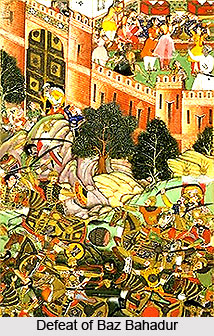 Miyan Bayezid Baz Bahadur was the last ruler of Malwa. He succeeded to the throne after his father, Shuja`at Khan and reigned from 1555 to 1562. He is known for his romantic liaison with Roopmati, a singer who was a Rajput by birth. His capital was Mandu that is now located in Madhya Pradesh. Mandu also served as an important city for the Mughal emperors also too.
Miyan Bayezid Baz Bahadur was the last ruler of Malwa. He succeeded to the throne after his father, Shuja`at Khan and reigned from 1555 to 1562. He is known for his romantic liaison with Roopmati, a singer who was a Rajput by birth. His capital was Mandu that is now located in Madhya Pradesh. Mandu also served as an important city for the Mughal emperors also too.
Baz Bahadur remained least interested in the administration of the kingdom and spent his time in company of singers and dancers. Though he was Muslim he was much drawn towards Hinduism. He did not even maintain a strong army hence when Akbar sent an officer named Adham Khan to conquer Malwa he abandoned his treasures and harem and fled. Adham Khan distributed part of the spoil among his soldiers and kept the treasures and harem for himself. The Mughals after defeating him captured his queen Rupmati, who killed herself at this turn of events.
Defeat of Baz Bahadur
In 1561, Akbar`s army led by Adham Khan and Pir Muhammad Khan attacked Malwa. In the battle of Sarangpur on 29 March, 1561 the Mughals quite easily defeated Baz Bahadur. One of the reasons for Adham Khan`s attack seems to be his love for Rani Rupmati. However Rani Rupmati poisoned herself to death on hearing the news of fall of the king. Leaving everything behind Baz Bahadur fled to Khandesh. Akbar soon recalled Adham Khan and handed over the command to Pir Muhammad who attacked Khandesh and proceeded up to Burhanpur. He was however defeated by a coalition of three powers: Miran Mubarak Shah II of Khandesh, Tufal Khan of Berar and Baz Bahadur. Pir Muhammad died while retreating and the confederate army chased the Mughals and drove them out of Malwa. For a short time period Baz Bahadur regained his kingdom but in 1562, Akbar sent another army led by Abdullah Khan, the Uzbeg that defeated Baz Bahadur. He fled to Chittor. Baz Bahadur remained a fugitive at a number of courts. In November, 1570 he finally surrendered to Akbar at Nagaur and joined Akbar`s service.



















